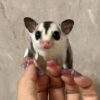Jelly
$250.00
Jelly Sugar Glider – A Sweet and Adorable Marsupial
The Jelly Sugar Glider is a charming and rare color morph of the sugar glider (scientific name: Petaurus breviceps), a small, nocturnal marsupial native to Australia, New Guinea, and parts of Indonesia. Sugar gliders are known for their gliding ability, big round eyes, and social behavior, but what sets the Jelly variant apart is its unique and eye-catching appearance.
What is a Jelly Sugar Glider?
The term “Jelly” refers to a specific color mutation in sugar gliders that results in a translucent or jelly-like sheen in their fur and skin. Unlike the common grey sugar gliders, Jelly sugar gliders may exhibit a pinkish or bluish undertone, with lighter fur that appears soft and glassy. This gives them a delicate and almost ethereal look, making them highly sought-after in the exotic pet world. While the term “jelly” isn’t yet scientifically classified as a separate breed or subspecies, it is widely recognized among breeders and enthusiasts for its aesthetic appeal and rarity. These sugar gliders still share the same general behaviors, needs, and lifespan as their standard-colored cousins.
Appearance and Behavior
Jelly sugar gliders typically weigh between 100 to 160 grams and have a body length of around 6 to 7 inches, with a similar length tail. Their most striking feature is, of course, their coloration — the slightly transparent skin, soft pastel fur, and glowing pink or purple tones in their ears, nose, and feet. Behaviorally, Jelly sugar gliders are energetic, curious, and very social. They bond closely with their human caregivers and thrive in pairs or small groups. Because they are nocturnal, they are most active during the night and enjoy gliding, climbing, and exploring their environment.
Diet and Care
Like all sugar gliders, the Jelly variant has a diverse diet. In the wild, they feed on tree sap, nectar, insects, and fruits. As pets, they require a balanced diet consisting of fresh fruits, specially formulated glider food, protein sources like boiled eggs or insects, and a calcium supplement to maintain bone health. Caring for a Jelly sugar glider involves providing a spacious cage with plenty of climbing toys, bonding pouches, and a gliding-friendly environment. These little marsupials are sensitive to temperature changes, so it’s important to maintain a warm and stable habitat.
Popularity and Ethical Considerations
Because of their rarity and beautiful appearance, Jelly sugar gliders are more expensive than standard ones. However, prospective owners should always source them from ethical breeders who prioritize the animals’ health and genetics over profit.
It’s also important to understand that sugar gliders require a lot of attention, social interaction, and specific care. They are not low-maintenance pets, and anyone considering adopting a Jelly sugar glider should be prepare for a long-term commitment — they can live up to 12–15 years in captivity with proper care. The Jelly Sugar Glider is a stunning and affectionate animal that adds a magical twist to the already lovable sugar glider species. With proper care, these gentle creatures can become loyal companions and a delightful part of any exotic pet family.
Be the first to review “Jelly” Cancel reply
Related products
Sugar Gliders For Sale
Sugar Gliders For Sale
Sugar Gliders For Sale
Sugar Gliders For Sale
Sugar Gliders For Sale

































Reviews
There are no reviews yet.